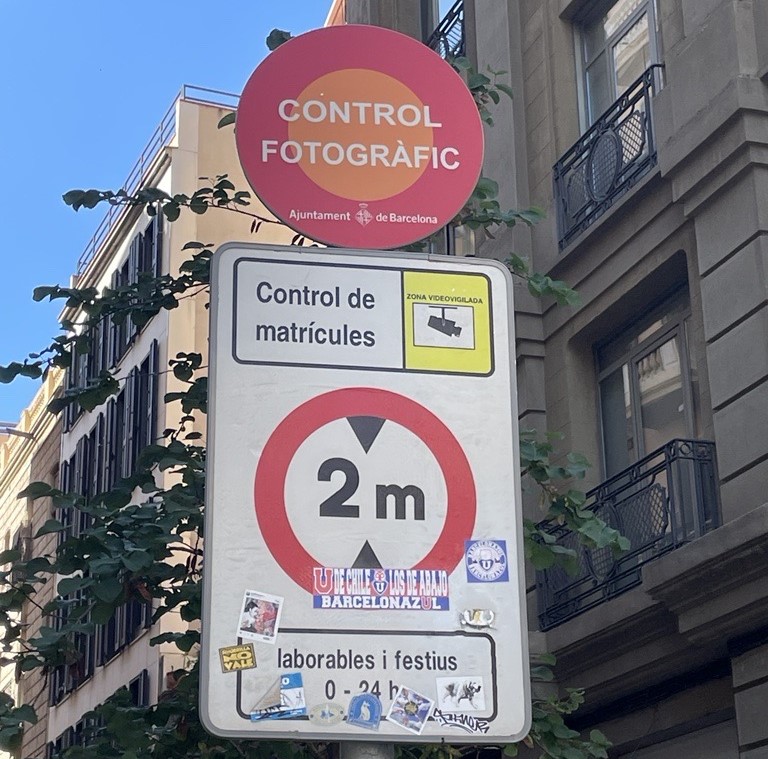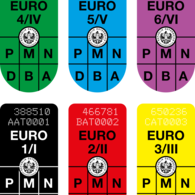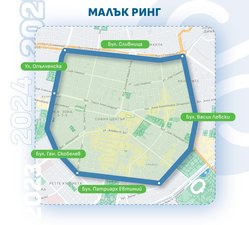Environmental zones in Europe
In recent years, local traffic restrictions and environmental zones have been introduced all across Europe. Each city decides whether to restrict access, one way or another, to certain categories of vehicles. Some cities require to have an environmental sticker on the car’s windscreen. Here's an overview of existing regulations country by country.
- Countries with environmental zones
- Countries with no environmental zones except some cities
- Countries without environmental zones
- No information
A highly disparate situation in Europe
Please note that there are no uniform regulation on environmental zones in the European Union! A sticker purchased in one EU country does not automatically allow you to drive in another. Such stickers are rarely recognised from one country to another. Remember to check the regulations for each city you are going to drive through, even within the same country.

Countries with environmental zones
Low emissions zones
In 42 towns and cities of France, you may need a Crit'Air sticker (air quality certificate) on your windshield. This is compulsory if you want to drive during certain times of the week, or in certain defined areas (so-called “ZFE” or “low-emission zones”). Each city decides on their exact restrictions. For example, with a Crit’Air 3 sticker, you may drive in Marseille and Strasbourg, but Paris and Lyon forbid access to these cars.
In total, there are 6 categories of Crit’Air stickers. 0 is for battery-driven cars, and 5 for the most polluting cars. If your car was registered before 1997, it will not even be eligible to the Crit’Air system.
You can order the sticker on Home page | Official website for the Crit'Air sticker (certificat-air.gouv.fr). It costs 3,81 euros. If you enter a low-emission zone without the sticker, you risk a fine of 68 euros.
Limited traffic zones
In addition, 4 cities in France have introduced limited traffic zones to reduce or even ban car traffic in city centres :
- Paris: the limited traffic area covers the 1st, 2nd, 3rd and 4th districts. In this area, motorised vehicles cannot drive, with certain exceptions. Look out for the road signs indicating the beginning of the restricted area.
- Nantes: the restricted area consists in streets reserved for pedestrians, cyclists, public transport and residents or workers. The area consists of two sectors. Vehicles displaying a yellow or purple sticker may access these sectors.
- Rennes: the limited traffic area covers the historic centre of Rennes. Only local residents, deliveries and emergency services can access this area. Pedestrians and cyclists have priority.
- Grenoble: traffic on the Rey and Agutte-Sembat boulevards in Grenoble is only for pedestrians, bicycles, public transport and authorised vehicles. Such vehicles must display a special sticker to the windscreen.

There are several low-emission zones across Belgium:
Brussels
The low-emission zone covers the entire perimeter of the Brussels-Capital region. Four-wheeled vehicles may not enter this area if they are running on diesel under the Euro 0, 1, 2, 3 and 4 standard or petrol under the Euro 0 and 1 standard. If your vehicle is non-compliant, you may exceptionally drive if you buy a daily pass for 35 euros. You can buy up to 24 per year.
Antwerp
The restricted area covers the city centre and the Left Bank, and concerns all diesel, petrol, LPG or natural gas vehicles. The city has a tool to check whether your vehicle is allowed entrance to the restricted area. Registration is compulsory for foreign vehicles, but free of charge if they fulfil the admission requirements.
Ghent
The restricted area covers the inner city. You can find the access requirements and a vehicle-checking tool here. Mopeds and motorbikes, electric vehicles and hydrogen-powered vehicles are not concerned by these restrictions. Registration is compulsory for foreign vehicles but allows access to all Flemish low-emission zones.
There are currently no low-emission zones in the Wallonia Region.
Since October 2023, the municipalities of Copenhagen, Frederiskberg, Aalbord, Odense and Aarhus have set up low emission zones with stricter rules for diesel-powered vehicles. Such cars must have a particulate filter for legal use in the low emission zones.
As of 1st March 2025, the low emission zone in Copenhagen is expanded.
Older vehicles must register on Miljøzoner EN (miljoezoner.dk) no later than the day they enter the low emission zone. Otherwise, you will receive a fine.
When you enter a low emission zone, cameras carry out the control using automatic licence plate recognition.
To drive in certain German towns and cities, it is compulsory to have an environmental sticker ("Umweltplakette") on your windscreen.
Some Italian cities have set up limited traffic zones ("Zona Traffico Limitato") to ban cars from historic city centres.
In addition, there are several low-emission zones in the Emilia-Romagna region during the winter months. The restrictions come into force on the 1st October each year until the following 31 March. They are activated from Monday to Friday (8.30 am – 6:30 pm).
From the 1st October 2025, vehicles of the Euro 5 diesel category are restricted in the urban areas of municipalities with more than 30.000 inhabitants, municipalities in the Bologna Agglomeration and others who wish to implement such restrictions.
For more information check: FAQ — Arpae Emilia-Romagna
A number of towns have chosen to introduce environmental zones in their centres, banning access to heavy goods and diesel vehicles.
Video surveillance cameras monitor these zones. Therefore, it isn’t necessary to register.
The fine varies from 75 euros for a two-wheeler to 280 euros for a lorry (110 euros for a light vehicle).
For further information :
- Amsterdam : The capital city has both a low and a zero emission zone: Low emission zone for diesel vehicles only - City of Amsterdam
- Arnhem : Milieuzone - Gemeente Arnhem and map of the zone : Milieuzone verkeer (arcgis.com)
- The Hague : The Hague - Low-emission zones in The Hague (denhaag.nl)
- Utrecht : Mobility | gemeente Utrecht. In 2025, these zones became stricter: cars and vans are not allowed to enter them unless their emission level is 4 or 5.
There are eco-zones in 3 of Norway's major conurbations: Oslo, Bergen and Kristiansand. To enter, you will have to pay a toll, the amount of which depends on the level of pollution caused by your vehicle.
The city of Oslo enforces temporary bans on Diesel vehicles on days with acute levels of air pollution. These decisions affect all municipal roads in Oslo.

In Spain, since January 2023, 149 towns and cities have introduced new low-emission zones (LEZ). This concerns the major cities (Madrid, Barcelona, Cordoba, Seville...) but also all towns with more than 50,000 inhabitants.
Vehicles with French number plates cannot purchase a Spanish sticker. However, Spain recognises the French Crit'air sticker. There is therefore no need to buy a Spanish sticker. Nonetheless, it's better to check the equivalence between the French classification and the Spanish classification.
In Barcelona, it is compulsory to register your vehicle before entering the city. If your vehicle meets the environmental criteria set by the city, you will have a long-term permit to drive in Barcelona. Otherwise, you will need to apply for occasional access limited to 24 days a year. The LEZ is active Monday to Friday from 7am to 8pm. You need to register online and pay a fee of 7 euros.
The cities of Stockholm, Malmö, Helsingborg, Göteborg, Lund, Mölndal, Umeå and Uppsala have set up environmental zones, banning heavy goods vehicles (>3.5 t) from these areas.
In a street in Stockholm named Hornsgatan, older petrol and diesel cars, as well as light buses and light trucks must meet at least the requirements for the Euro 5 emission class to cross this street. This also applies to vehicles that have ethanol, biogas or natural gas as fuel.
Two eco-zones in London
There are two eco-zones in Greater London:
Vehicles must be registered in advance, and checks are carried out using video surveillance cameras.
There is also a £15/day congestion charge.
To check whether you have to pay tax for these three zones, see :
Fines for non-payment are £180 for the ULEZ and between £250 and £2,000 for the LEZ.
Note ! A debt collection company has been appointed by the City of London to send out the requests for payment, Euro Parking Collection plc (epcplc.com).
How do I dispute the fine?
If it was not your vehicle or if you can prove that you paid the toll, appeal against the decision by writing directly to Transport for London (TfL) or on Euro Parking Collection (EPC).
What happens if I don't pay the fine?
If you do not challenge the fine, or if the challenge is unsuccessful, you must pay the fine in accordance with UK law.
If you fail to pay, you will be liable to reminders and surcharges.
Direct enforcement of the fine by EU authorities is no longer possible since the UK left the EU, but this does not affect the validity of the decision in the UK.
Other clean air zones exist across England:
- Bath
- Birmingham
- Bradford
- Bristol
- Portsmouth
- Sheffield
- Tyneside (Newcastle and Gateshead)
There are currently no active clean air zones in Wales or in Northern Ireland.
For rules concerning the clean air zones in the Scottish cities of Edinburgh, Glasgow, Aberdeen and Dundee, check: Low Emission Zones Scotland | Transport Scotland.
Countries where there are no eco-zones, with some exceptions

There are environmental zones only for heavy-goods vehicles. Driving restrictions apply on the A12 motorway, in Burgenland, Graz, Lower Austria, Upper Austria, Styria and Vienna. To avoid heavy fines, drivers should order online an emision sticker.
If you are driving a normal vehicle, these environmental zones do not apply to you. However, don’t forget to buy Austria’s motorway toll sticker!


The capital, Sofia, is introducing a low-emission zone in winter. The zone is active every year from December 1 to February 28. Cars with Euro 0-3 petrol and Euro 0-5 diesel emission standards are can't drive inside the city's small and big ring roads (see the maps below). If your vehicle complies with the authorised standards, you can drive in the centre and you do not require any sticker or registration.
Entry in the ring roads are signposted, and cameras monitor any vehicle entering. Anyone breaking the rules risks a fine of at least 50 lev (around 25 euros).
Only the capital, Prague, has a low emission zone for lorries and coaches over 3.5 tonnes. There are no low-emission zones for private vehicles.
The city of Brno, on the other hand, has set up a pedestrian zone. To drive in the historic city centre, you need a special permit.
There are no environmental zones in Finland, with the exception of the city of Helsinki. The latter has created an eco-zone restricting access and traffic to buses and bin lorries in certain parts of the city.
There are no environmental zones in Greece, with the exception of Athens and Thessaloniki.
In Athens, the low-emission zone corresponds to the Athens Ring. To operate within this zone, vehicles must meet one of the following criteria:
- Electric vehicles
- Factory-built natural gas or LPG vehicles
- Hybrid vehicles
- Euro 6 vehicles emitting less than 120g of CO2 for vehicles registered before 2021, or less than 145g of CO2 for vehicles registered from 2021.
Cars registered in Greece may apply for a special traffic pass online, but foreign cars have to get in touch with the Attica Traffic Directorate.
The Athens Ring operates through an odd-even number plate system. Vehicles with license plates ending in an odd number may enter the restricted area on odd dates, and vice versa.
In Thessaloniki, the low-emission zone only applies to diesel vehicles above 2.2 tonnes (mainly heavy goods vehicles and buses).
Only the capital city, Budapest, has implemented an access-regulated area. There are 11 protected zones and 15 restricted zones in the city.
The protected zones are historic sites or recreational green spaces where there are no cars allowed.
On the other hand, restricted zones correspond to certain areas of the city where heavy duty vehicles need a permit to enter. The cost depends on their total weight and vehicle emissions.
Sometimes, the city of Budapest can issue a smog alert, meaning that vehicles with an emission standard lower than Euro 5 cannot enter the city centre from 6:00am to 10:00pm. They usually announce smog alerts one to two days in advance.
There are no environmental zones in Iceland. However, some streets in town centres are closed to traffic during the summer months or at certain times of the day.
Since 1 February 2024, you must pay a fee of 3€ to enter the city of Jūrmala with a car.
In the capital Riga, a large pedestrian area restricts access to vehicles. The city has also implemented restriction to vehicles heavier than 5 tons.
The city of Kauna has introduced a reduced pollution zone. Cars entering this zone have to pay a 2-euro fee. You can pay this tax at parking meters or via parking applications.
In Vilnius, the capital city, there are still no active environmental zones, but city council is planning on implementing one in the city’s Old town. The chosen area has been designated since January 2025, but the restrictions are not active yet. Apart from that, there are several “quiet traffic streets”, in which the speed limit is 30 km/h.
There are no environmental zones in Malta, with the exception of the city of Valletta, which has introduced a vehicle access control system in the city centre called City Vehicle Access (CVA).
This system uses cameras installed at entry and exit points in the city. You pay a fee based on the time you spend in the city centre, before or after you pass through.
Residents are not subject to this charge.
Currently, two cities (Warsaw and Kraków) have created a "clean transport zone" that applies to residents and tourists. Electric vehicles are automatically allowed within this zone.
For all others, you can check whether your vehicle meets the criteria for the Warsaw low-emission zone and for the Kraków zone.
You don't need a sticker. Cameras check the number plates of vehicles entering the zone. If you don’t respect the rule, the fine amounts to 500 zloty (around 117 euros).
The city of Wrocław is also planning to introduce a clean transport zone in the near future. Implementation will start between July 2025 and July 2026.
There is only one low emission zone in Portugal. The city of Lisbon is divided into two zones (zone 1 and zone 2), each with its own standard. Zone 1 requires a Euro 3 standard, while zone 2 requires a Euro 2 standard.
The city of Porto has a “conditioned access zone” which regulates the vehicles that can enter certain neighbourhoods in its historic city centre. You need registration for access, but the criteria used is not environmental.
There are currently no environmental zones yet in Romania. However, some cities, including Bucharest will soon implement low-emission zones.
In Bucharest, the implementation has already started and will take approximately two years (2025-2027). The plan is to gradually restrict access to the city for the most polluting vehicles. Cameras placed at entry points of the zone will automatically identify license plates and record non-compliant cars.
12 other major urban areas, such as Brașov, Cluj-Napoca, Constanța, Craiova, Iași, Ploiești, and Timișoara, will soon follow and establish low-emission zones as well.
There are no environmental zones in Slovenia. However, the capital city, Ljubljana, has implemented a pedestrian zone, making its city centre car-free. Access is forbidden to any motor vehicle. The only exceptions are for deliveries and residents.
Countries without environmental zones
There are no environmental zones in the following countries: Estonia, Ireland, Luxembourg, Croatia, Cyprus and Slovakia.
Funded by the European Union. Views and opinions expressed are however those of the author(s) only and do not necessarily reflect those of the European Union or the European Innovation Council and Small and Medium-sized Enterprises Executive Agency (EISMEA). Neither the European Union nor the granting authority can be held responsible for them.

